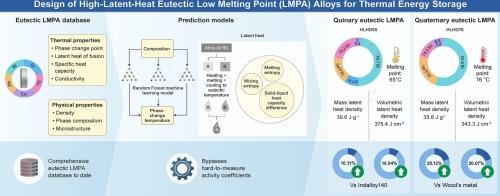基于预测模型和标准化实验的低熔点高潜热合金研究
IF 7.9
2区 材料科学
Q1 MATERIALS SCIENCE, MULTIDISCIPLINARY
引用次数: 0
摘要
本研究通过实施标准化的样品制备程序和表征方法,解决了现有文献中的差异,从而建立了迄今为止最全面的共晶低熔点合金(LMPA)相变点数据库。提出了一种基于机器学习的(随机森林)相变点预测模型,有效克服了传统基于活度系数方法的实际局限性。此外,提出了一种结合熔融熵、混合熵和固液热容差的潜热预测模型,该模型对四元和五元体系具有较高的预测精度。在这些模型的指导下,设计了两种高性能LMPA (HLHD65和HLHD76): HLHD65的质量潜热密度和体积潜热密度分别比Indalloy 140高10.31%和10.54%,HLHD76的质量潜热密度和体积潜热密度分别比Wood的金属高20.13%和20.07%。这项工作为开发先进的热能储存材料提供了坚实的基础,并建立了一个范例。本文章由计算机程序翻译,如有差异,请以英文原文为准。

Development of low melting point alloy with high latent heat based on predictive models and standardized experiments
This study addresses discrepancies in existing literature by implementing standardized sample preparation procedures and characterization methods, thereby establishing the most comprehensive phase change point database for eutectic low-melting-point alloy (LMPA) to date. A machine learning-based (random forest) phase change point prediction model was developed, effectively overcoming the practical limitations of traditional activity coefficient-based approaches. Furthermore, a latent heat prediction model incorporating melting entropy, mixing entropy, and the solid–liquid heat capacity difference was proposed, demonstrating superior accuracy for quaternary and quinary systems. Guided by these models, two high-performance LMPA (HLHD65 and HLHD76) were designed: HLHD65 achieves 10.31 % and 10.54 % higher mass and volumetric latent heat density, respectively, than Indalloy 140, while HLHD76 demonstrates improvements of 20.13 % and 20.07 % over Wood’s metal. This work provides a robust foundation and establishes a paradigm for developing advanced thermal energy storage materials.
求助全文
通过发布文献求助,成功后即可免费获取论文全文。
去求助
来源期刊

Materials & Design
Engineering-Mechanical Engineering
CiteScore
14.30
自引率
7.10%
发文量
1028
审稿时长
85 days
期刊介绍:
Materials and Design is a multi-disciplinary journal that publishes original research reports, review articles, and express communications. The journal focuses on studying the structure and properties of inorganic and organic materials, advancements in synthesis, processing, characterization, and testing, the design of materials and engineering systems, and their applications in technology. It aims to bring together various aspects of materials science, engineering, physics, and chemistry.
The journal explores themes ranging from materials to design and aims to reveal the connections between natural and artificial materials, as well as experiment and modeling. Manuscripts submitted to Materials and Design should contain elements of discovery and surprise, as they often contribute new insights into the architecture and function of matter.
 求助内容:
求助内容: 应助结果提醒方式:
应助结果提醒方式:


